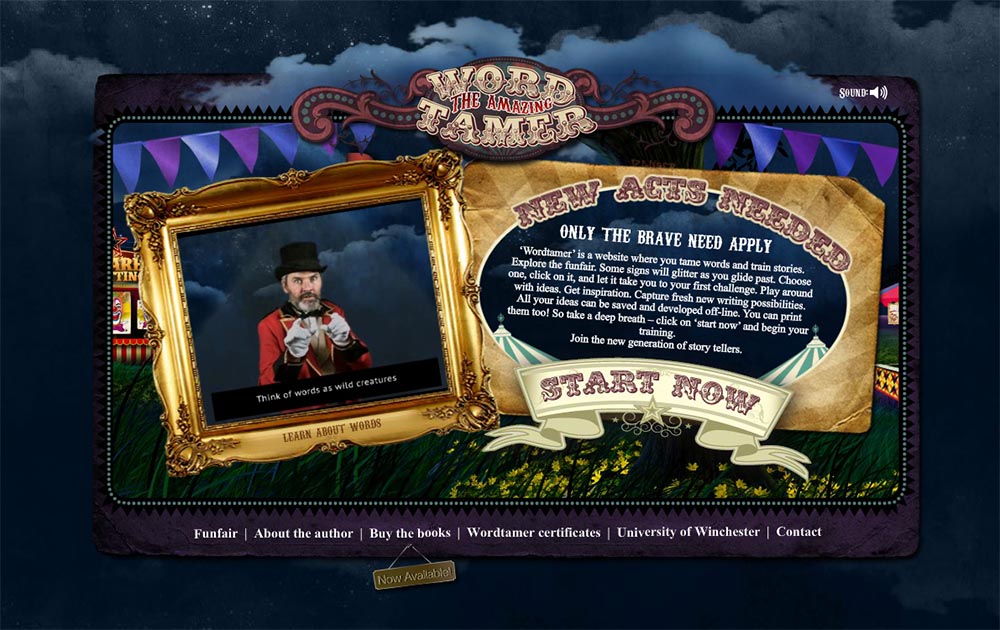
Judy Waite, Senior Lecturer in Creative Writing at the University of Winchester, discusses her ten-year journey to develop resources to help teachers use Information Computer Technology (ICT) and other tools to bring creativity back to the classroom.
As an author who is a regular visitor into schools, I once asked a teacher how a creative writing module - which formed part of the assessment for General Certificate of Secondary Education (GCSE) in English - was to be marked. I was told that, among other things, pupils needed to show correct usage of the semi-colon and to include at least one example of it in their writing. Consequently, when he marked pupil work his focus was on SPAG (he wasn’t hungry – this is not a form of pasta, but an educational acronym referring to Spelling, Punctuation and Grammar). He didn’t look at creative content because there were no criteria to mark it by.
Tragic though it seemed, I understood his stance. Schools were (and still are) under constant scrutiny and unbelievable pressures related not only to their pupils’ performance, but their own.
Still, I had always believed that everyone wanted creativity and creative writing in schools – it was just that it was gasping for breath, being swallowed in the sea of tests and tasks and ongoing assessments.
But I discovered I was wrong.
These were conversations I had with two different parents on two different occasions; “I can’t see the point of her learning creative things at school. She can do that at home. I want her to learn things that will help her pass exams.” And secondly, a different mum; “I usually write his homework stories for him and he just copies them out neatly. I do his art for him too. It doesn’t matter, does it? It’s not like he’s ever going to get job as an author or an artist”.
Of course, parts of me were crumbling into that swirly sea, but I also felt no amount of impassioned pleas would make them do anything more than smile politely as I drowned. That second mum was probably too busy drawing stick-men to even notice.
I learnt, many years ago (and via a different story), that there is almost no value in swimming against the tide. You end up bashed up on the rocks, sharks circling. Small fish nibbling at your toes. But you can swim with the tide AND move at an angle, or perhaps head towards those rocks no one has noticed…
I began my slightly angled, ‘distant rock’ swim.
My research showed me that the Office for Standards in Education (Ofsted) had identified the underdevelopment of Information and Communication Technology (ICT) skills in schools, with unsatisfactory gaps between the worst and best practice, and with best practice being described as: video stories, web sites, electronic communication with authors and the development of animations. They highlighted the fact that this gap included actual structuring of English lessons, with weaker results being gained from ‘front ended introductions on the interactive whiteboard, with the interactive content and potential of this technology not being embraced.’ (Ofsted 2009)
So I started thinking – what about bringing these strands together? Combining English and literacy/story-telling with ICT?
I was not (am not) an ICT specialist – I love the medium but only have a basic grasp of how it functions - but in order to reach out to this generation so seduced by a range of endlessly more glamorous options, I felt I needed to embrace it. If I really could ‘face the beast’ of technology and connect it with my creative writing knowledge and experience, I could perhaps better connect with not only this upcoming generation, but the adults too.
It took three years and much toil, but the website was launched in September 2013: www.wordtamer.co.uk – an interactive website that invites young writers to follow the wordtamer into the fairground and make ‘stars out of their stories.’ There are genre ideas to be found in a moving carousel. Stories can be shot down from the ‘clown-shoot’ activity, or characters captured through hook-a-duck. Enter the mirror maze and see how plots change shape. A starry sky swirls words that weave wonders.

Ten years later and the site is still thriving but, in teacherish speak, did I meet my own objectives?
Wordtamer does connect ICT with creative writing.
It does enable reluctant (pupil) writers to engage with creative ideas and story-telling. It also has value for skilled writers. It was a delight when a teacher recently tweeted me to say she was exploring the site and ‘found herself writing a story by accident’. I loved the whole concept of stories being started by accident. Not through necessity, and not angsted over – just enjoyed.

But back to my own intentions. Wordtamer connects IT skills with creative thinking and literacy in schools, answering the 2010 Ofsted brief as well as my own.
It saves and even prints work so pupils can work offline, editing and adapting their ideas – they can pepper in those semi-colons and enjoy language intermingled with that delicious SPAG sauce – there is even a certificate that can be printed and used as an award. So it does tick that ‘teacher’ box too – but does it help those parents who think that creativity in schools is a waste of time? I’d like to think so. Maybe, as I float on an ocean of dreams, I can start to believe that some of them even use the site themselves – with their children – creating stories together. Now that, for me, would be one giant tick.
One final reflection on Wordtamer – the original website has led me somewhere new; somewhere I couldn’t have gone without all the early research and explorations. My resource book Wordtamer (2017) keeps the same intentions but expands all the possibilities. It offers depth and theory, plus over fifty original creative activities and ideas for writing. Perhaps that is the greatest thing of all about creative endeavour. There is no full-stop. No ‘that’s it, I’m done’, tidied up with an affirming exclamation mark. Each ending is actually a new chapter starting. The more we use our creativity, the more creativity we have to use, and that is the overall premise that weaves through the whole wordtamer project. Everyone is creative. Just imagine that.
Wordtamer: Activities to Inspire Creative Thinking and Writing (Routledge (Taylor & Francis) group) combines academic findings and practical activities in an engaging resource book for primary and secondary schools. It is now available from: www.winchester.ac.uk/wordtamer
References:
Waite, Judy. (2017) Wordtamer London: Routledge
Back to media centre